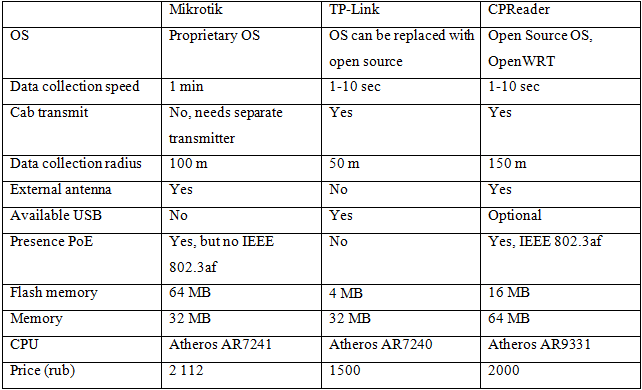ФОРМУЛИРОВАНИЕ ТРЕБОВАНИЙ И СОЗДАНИЕ УСТРОЙСТВА ДЛЯ СБОРА ДАННЫХ ИЗ ОТКРЫТЫХ ПАКЕТОВ WI-FI-СЕТИ
Иванов Д.А.1, Иванов А.Л.2, Суровцова Т.Г.3
1ООО «ФинВан», 2Филиал «Российской телевизионной и радиовещательной сети (РТРС)» «РТПЦ Республики Карелия», 3Кандидат технических наук, Петрозаводский государственный университет
Работа выполнена в рамках Программы стратегического развития Петрозаводского государственного университета на 2012–2016 гг.
ФОРМУЛИРОВАНИЕ ТРЕБОВАНИЙ И СОЗДАНИЕ УСТРОЙСТВА ДЛЯ СБОРА ДАННЫХ ИЗ ОТКРЫТЫХ ПАКЕТОВ WI-FI-СЕТИ
Аннотация
Мобильные устройства активно используют Wi-Fi-сети для выхода в Интернет. Необходимы бюджетные точки доступа, которые позволили бы осуществлять сбор данных из открытых пакетов Wi-Fi-сетей. Подобные устройства являются составной частью аппаратно-программных комплексов, осуществляющих наблюдение в радиоэфире за разнообразными мобильными устройствами.
Ключевые слова: Wi-Fi локация, Wi-Fi сеть, сбор и анализ данных, точка доступа, мобильное устройство.
Ivanov D.A.1, Ivanov A.L.2, Surovtsova T.G.3
1ThinOne Ltd, 2Branch of Russian Television and Radio Broadcasting Network (RTRS) «RTBC Republic of Karelia», 3PhD in Engineering, Petrozavodsk State University
REQUIREMENTS DEFINITION AND IMPLEMENTATION OF THE APPARATUS FOR DATA COLLECTION FROM OPEN PACKETS OF WI-FI NETWORKS
Abstract
Mobile devices actively use Wi-Fi for Internet connectivity. Low cost access points are required to allow data collection from open packets of the Wi-Fi networks. These access points are part of hardware and software based solution that monitors radio of the various mobile devices.
Keywords: Wi-Fi location, Wi-Fi network, mobile device, data collection and processing, access point.
For the past years number of mobile devices have increased significantly due to smart phones and wearables. These mobile devices use Wi-Fi networks to access Internet services. Even if available Wi-Fi network is not present, the devices use broadcast packets when searching for network to connect. It is possible to monitor radio transmission of the Wi-Fi frequencies (IEEE 802.11 a/b/g/n) to collect and process data about known devices [1].
The data collected can be used to offer various services that analyze behavior of the devices of Wi-Fi network. Subscribers can also be identified by devices [2].
We have analyzed of existing access points available on the marked by their features. The result can be found in the Table 1.
Since none of existing access points satisfy requirements, we decided to develop our own access point for domestic production however using some foreign components.
Table 1 – Comparison of the technical parameters of products
As a result we have formulated requirements for our own device, CPReader, that collects information from open packets of Wi-Fi networks, as follows:
- compactness and minimal number of components;
- components have to be easily replaceable for quick serviceability, low operation costs;
- use open source software;
- can use various power sources including PoE as well as backup power source must be supported;
- sufficient internal memory for custom scripts and local data collection, if real time data transmission is not possible;
- ability to control radio interface;
- can be easily prototyped and then produced at marginal cost.
We have been able to implement all of these requirements quickly and produced motherboard for CPReader, see table above, with following features:
- can collect data about mobile devices form their broadcast packets of Wi-Fi networks, MAC address, signal strength and timestamp, latter used to time synchronize data for location;
- internal storage to collect data;
- interface that supports various antennas;
- supports PoE;
- can be put in dust and waterproof enclosure for outdoor use;
- assembled domestically.
All the components that CPReader is built from are used within recommended manufacturer's parameters that addresses potential compatibility and reliability questions. We have used several improvements of our own to achieve better performance.
CPReader's based solution have good scalability and flexible enough to support additional requirements with minimal effort.
We have successfully tested CPReader on several exhibitions and public events and demonstrated that it can be used to collect data from Wi-Fi network, for example for background control of attendance [2].
CPReader's software was developed to collect data packets. Packets are processed and sent to the cloud, where data can be used to create location, visualization and aggregation services. Special attention was paid data buffering. In the case of a lack of communication, data is stored on the device and sent only in the event of connection. If a large number of subscribers is fixed, then the volume of data collected with access point is increasing. Number of records can reach several million. Special procedures are required to send and load such a large amount of data in the database. Importantly, in the case of mobile devices location is need to use several access points, which are synchronized in time.
Conclusion
Even though all initial requirements have been met, we are constantly improving CPReader's software and hardware using field test data. Any problems that have been found do not impact main function of the device and will be used for possible future versions of this solution.
References
- Srinivasan K., Philip L. RSSI Is Under-Appreciated. // In Proceedings of the Third Workshop on Embedded Networked Sensors (EmNets), 2006. URL: https://sing.stanford.edu/site/publications/emnets2006srinivasan.pdf.
- Ivanov D. A., Surovtsova T. G., Tyahti E. A. Analiz aktivnosti v besprovodnyh setjah kak innovacionnyj metod izuchenija povedenija pokupatelej v torgovyh centrah // Nauchno-tehnicheskie vedomosti SPbGPU, 2013. № 183 (2). P. 271-275.

